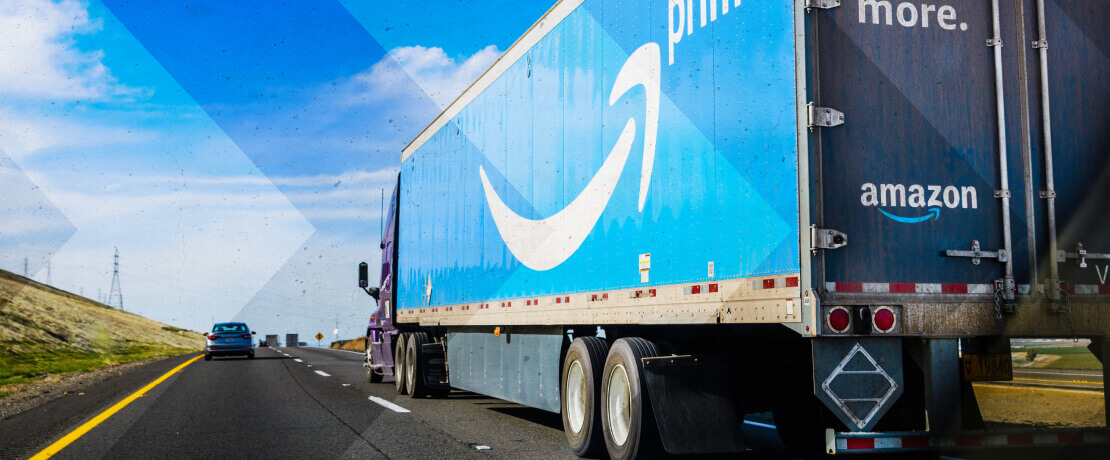Amazon Prime Day 2020: Logistics and Trucking Industry Impacts

Amazon (NASDAQ: AMZN) has moved its Prime Day up to October 13 – 14 this year. Amazon Prime Day usually leads to a high surge in online shopping, and this year’s two-day event kicks off the holiday shopping season early. Typically held in July, the date change is due to Covid-19’s impact. Amazon couldn’t handle the volume this past July given the pandemic. They also faced labor concerns, with more than 20,000 workers testing positive for Covid-19.
Shifting to the October date is a genius strategy, given the record number of brick-and-mortar store closures. One concern, though, is that it will strain the logistics and trucking industries that have to carry those loads. Driver shortages and unexpected demand on delivery timetables can further stretch these industries already reeling from the pandemic.
Here’s a look at how Prime Day has impacted logistics and shipping in the past, and what effects Covid-19 might have on the industry later this year.
When is Amazon Prime Day 2020?
Prime Day is Tuesday, October 13, and Wednesday, October 14. The annual sale is usually held in mid-July and considered a summer Black Friday event. But last year’s event extended from 36 hours to 48 hours. Prime sales aren’t restricted to retail, as they include deals at Whole Foods and Prime Video. This incentivizes consumers to renew their subscriptions or start a free trial. With a free 30-day trial, customers get free two-day shipping. Amazon’s second-quarter sales spiked 44% last quarter, and they’re capitalizing on features like contactless delivery.
To support the uptick in sales, Amazon expanded its fulfillment network by 50%. This comes at the right time: More brick-and-mortar retailers are shifting to eCommerce environments during the pandemic. On top of that, retail chains like Neiman Marcus, JCPenney, and Century 21 recently filed for bankruptcy protection, potentially turning the holiday shopping season into a retail apocalypse.
With record store closures, a stalling economy, and safer-at-home consumer attitudes, Amazon is targeting online shoppers hungry for deals and fast deliveries.
How Amazon Prime Day impacts the freight and trucking industries.
With traditional retailers suffering from the lockdowns, a huge chunk of holiday sales will happen near Prime Day instead of November, pushing schedules and demand more than a month earlier. Other concerns include is a U.S. Postal Service (USPS) backlog from mail-in ballots and potential stay-at-home orders forcing retailers and consumers online.
More concerns for Logistics and Trucking industries
Amazon could reach record profits as it cannibalizes on deals that usually aren’t offered until Black Friday and Cyber Monday. This will put more strain on the logistics and trucking industries to deliver. To make matters worse, other eCommerce retailers are adjusting staff levels and changing holiday schedules to compete with Amazon.
Target’s Deal Days sale is also on October 13 and 14, the same days as Amazon’s event. While Amazon added 100,000 new employees, Walmart hired 20,000 additional workers.
Another concern is Thanksgiving store closures. Walmart and Target are closing their physical locations for Thanksgiving. While this limits the crowds, it pushes more holiday shoppers online. This can lead to more delays with deliveries.
Post-Prime Day sales might also contribute to this logistics nightmare. Amazon has sales planned every week for three weeks starting October 26. Walmart’s The Big Save is October 11 – 15. Their loyalty program includes unlimited deliveries (and includes free grocery delivery). The problem this creates is driver shortages and a capacity crisis. It’s concerning, as trucking business may need more refrigerated trucks for perishable goods.
Millions of merchants that market products on Amazon’s site can expect a boost in sales from Prime Day. Amazon can fulfill more orders because their holiday sales start in October, not the traditional last week of November. Warehouse workers will ship items from October 13 to October 20. With additional time for order fulfillment, Amazon is readying its warehouses and fulfillment centers. But the stress on logistics and trucking industries is what analysts are calling “The Perfect Storm.”
How Prime Day will impact freight logistics
Several factors go into how carriers meet demand. Despite rates increasing up to 30% within the last year, there’s a decline in the number of available carriers. Logistics disruptions began before the pandemic.
With the capacity crisis, a major concern is driver shortages. This began in 2012, but it’s estimated that driver jobs will increase 6% annually through 2026. Aging drivers have to push to deliver time-sensitive loads in a pandemic, and the weather doesn’t help. A late hurricane season can add residual winds from Hurricane Delta as it slowly moves up the Gulf Coast.
Then there’s driver fatigue. Because Amazon has sales scheduled back-to-back after October 26, drivers may not have a break before the holiday season. Walmart, Target, and other businesses offering free and unlimited shipping increases the likelihood of delays. According to deal-comparison site RetailMeNot, 250 websites offered competitive deals on Prime Day last year — and that’s without COVID-19. So, trucking and logistics businesses need to prepare now to meet demand.
Shipping during Prime Day and what to expect
Though Amazon has its own delivery fleet, some packages still ship through regular mail. A possible USPS mail-in voting overload for the election could affect drivers. Fortunately, Prime Day deliveries ship before voting ballots are due.
Businesses like Amazon, Target, and Walmart are expecting record sales. Plan for a sharp spike in deliveries and prepare now for the sudden increase, not in late November. Consider having extra drivers on hand at distribution centers or for local deliveries to help meet short turnarounds.
With Amazon Fresh grocery deliveries included in Prime Day, you may need more refrigerated trucks to meet the demand for perishable products. Having smaller trucks ready for same-day and short deliveries may also help.
Aside from needing more drivers and trucks, another concern is diesel fuel. Budgeting for higher fuel costs can help prepare for Amazon’s next sale on October 26. Lastly, in areas where there is high demand, ready more drivers and trucks. And, keep an eye on the forecast. The active hurricane season isn’t letting up so far.
The COVID-19 factor: How will the pandemic affect Prime Day?
With some warehouses shut down, drivers are in shorter supply. But keeping them safe is still a huge undertaking. Increasing drivers can help, but cleaning and sanitizing trucks and common areas is also important.
Keep these CDC COVID-19 driver protocols in mind:
- Comply with all FMCSA regulations and stay home if you’re sick.
- Use hand sanitizers, gloves, and masks.
- Wear face coverings at all times. Avoid touching your face when wearing gloves.
- Never share personal protective equipment (PPE).
- Clean truck cabs and sleeping berths. Install barriers for team drivers.
- Use hand sanitizer and practice proper hand hygiene (washing hands after pumping gas).
- Anticipate more curbside, contactless deliveries, and use pre-qualified truck stops.
- Follow social distancing: Maintain a six-foot distance from others.
- Avoid sharing pens, scanners, and other equipment on routes.
- Wipe down trucks and clean all surfaces (clipboards, pens, electronic devices) with disinfectant.
- Eat before/after but not during shifts.
What can we do about it?
Prepare trucks and drivers for the upcoming surge in sales to meet demand with these best practices:
- Watch for shipment delays due to hurricane season. Know all alternate routes. Use online tools to monitor trucks and routes. Hire temporary drivers and assistants to keep drivers on schedule.
- Anticipate rate increases or surges in gas prices to help manage cash flow.
- Expect potential capacity constraints. With millions of shoppers expecting immediate deliveries, address load capacities now. Treat Prime Day like Black Friday and consider working with partners to help meet demand.
- Use the best TMS and automate all processes. This provides instant access to drivers, routes, and real-time shipping.
- Have extra refrigerated trucks ready. With Amazon Fresh, Target, and Walmart offering groceries, having refrigerated trucks ready is imperative.
- Require all drivers to adhere to CDC COVID-19 protocols around contactless deliveries, hand washing, and social distancing.
With Amazon Prime Day scheduled for October 13 and 14, now is the time to prepare. Anticipate delays and gear up for Amazon’s next sale starting October 26. With helpful API Integrations at your fingertips, Truckstop.com lets you track and view available loads to keep your drivers busy throughout the holiday season.
Topics:
Get helpful content delivered to your inbox.
Sign up today.
Find high-quality loads fast, get higher rates on every haul, and access tools that make your job easier at every turn.






